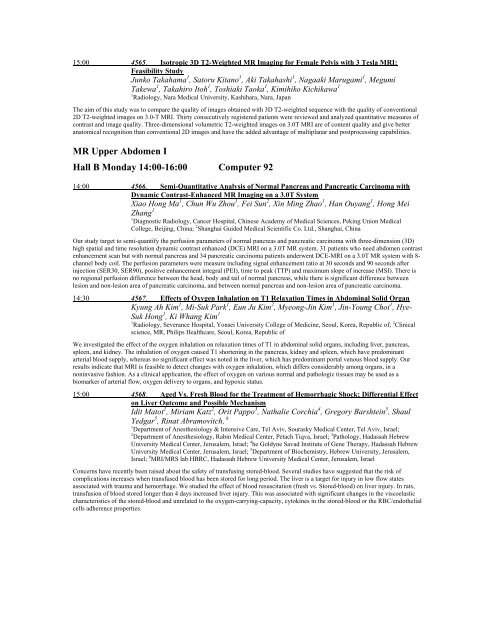ELECTRONIC POSTER - ismrm
ELECTRONIC POSTER - ismrm
ELECTRONIC POSTER - ismrm
Create successful ePaper yourself
Turn your PDF publications into a flip-book with our unique Google optimized e-Paper software.
15:00 4565. Isotropic 3D T2-Weighted MR Imaging for Female Pelvis with 3 Tesla MRI:<br />
Feasibility Study<br />
Junko Takahama 1 , Satoru Kitano 1 , Aki Takahashi 1 , Nagaaki Marugami 1 , Megumi<br />
Takewa 1 , Takahiro Itoh 1 , Toshiaki Taoka 1 , Kimihiko Kichikawa 1<br />
1 Radiology, Nara Medical University, Kashihara, Nara, Japan<br />
The aim of this study was to compare the quality of images obtained with 3D T2-weighted sequence with the quality of conventional<br />
2D T2-weighted images on 3.0-T MRI. Thirty consecutively registered patients were reviewed and analyzed quantitative measures of<br />
contrast and image quality. Three-dimensional volumetric T2-weighted images on 3.0T MRI are of content quality and give better<br />
anatomical recognition than conventional 2D images and have the added advantage of multiplanar and postprocessing capabilities.<br />
MR Upper Abdomen I<br />
Hall B Monday 14:00-16:00 Computer 92<br />
14:00 4566. Semi-Quantitative Analysis of Normal Pancreas and Pancreatic Carcinoma with<br />
Dynamic Contrast-Enhanced MR Imaging on a 3.0T System<br />
Xiao Hong Ma 1 , Chun Wu Zhou 1 , Fei Sun 2 , Xin Ming Zhao 1 , Han Ouyang 1 , Hong Mei<br />
Zhang 1<br />
1 Diagnostic Radiology, Cancer Hospital, Chinese Academy of Medical Sciences, Peking Union Medical<br />
College, Beijing, China; 2 Shanghai Guided Medical Scientific Co. Ltd., Shanghai, China<br />
Our study target to semi-quantify the perfusion parameters of normal pancreas and pancreatic carcinoma with three-dimension (3D)<br />
high spatial and time resolution dynamic contrast enhanced (DCE) MRI on a 3.0T MR system. 31 patients who need abdomen contrast<br />
enhancement scan but with normal pancreas and 34 pancreatic carcinoma patients underwent DCE-MRI on a 3.0T MR system with 8-<br />
channel body coil. The perfusion parameters were measure including signal enhancement ratio at 30 seconds and 90 seconds after<br />
injection (SER30, SER90), positive enhancement integral (PEI), time to peak (TTP) and maximum slope of increase (MSI). There is<br />
no regional perfusion difference between the head, body and tail of normal pancreas, while there is significant difference between<br />
lesion and non-lesion area of pancreatic carcinoma, and between normal pancreas and non-lesion area of pancreatic carcinoma.<br />
14:30 4567. Effects of Oxygen Inhalation on T1 Relaxation Times in Abdominal Solid Organ<br />
Kyung Ah Kim 1 , Mi-Suk Park 1 , Eun Ju Kim 2 , Myeong-Jin Kim 1 , Jin-Young Choi 1 , Hye-<br />
Suk Hong 1 , Ki Whang Kim 1<br />
1 Radiology, Severance Hospital, Yonsei University College of Medicine, Seoul, Korea, Republic of; 2 Clinical<br />
science, MR, Philips Healthcare, Seoul, Korea, Republic of<br />
We investigated the effect of the oxygen inhalation on relaxation times of T1 in abdominal solid organs, including liver, pancreas,<br />
spleen, and kidney. The inhalation of oxygen caused T1 shortening in the pancreas, kidney and spleen, which have predominant<br />
arterial blood supply, whereas no significant effect was noted in the liver, which has predominant portal venous blood supply. Our<br />
results indicate that MRI is feasible to detect changes with oxygen inhalation, which differs considerably among organs, in a<br />
noninvasive fashion. As a clinical application, the effect of oxygen on various normal and pathologic tissues may be used as a<br />
biomarker of arterial flow, oxygen delivery to organs, and hypoxic status.<br />
15:00 4568. Aged Vs. Fresh Blood for the Treatment of Hemorrhagic Shock; Differential Effect<br />
on Liver Outcome and Possible Mechanism<br />
Idit Matot 1 , Miriam Katz 2 , Orit Pappo 3 , Nathalie Corchia 4 , Gregory Barshtein 5 , Shaul<br />
Yedgar 5 , Rinat Abramovitch, 6<br />
1 Department of Anesthesiology & Intensive Care, Tel Aviv, Sourasky Medical Center, Tel Aviv, Israel;<br />
2 Department of Anesthesiology, Rabin Medical Center, Petach Tiqva, Israel; 3 Pathology, Hadassah Hebrew<br />
University Medical Center, Jerusalem, Israel; 4 he Goldyne Savad Institute of Gene Therapy, Hadassah Hebrew<br />
University Medical Center, Jerusalem, Israel; 5 Department of Biochemistry, Hebrew University, Jerusalem,<br />
Israel; 6 MRI/MRS lab HBRC, Hadassah Hebrew University Medical Center, Jerusalem, Israel<br />
Concerns have recently been raised about the safety of transfusing stored-blood. Several studies have suggested that the risk of<br />
complications increases when transfused blood has been stored for long period. The liver is a target for injury in low flow states<br />
associated with trauma and hemorrhage. We studied the effect of blood resuscitation (fresh vs. Stored-blood) on liver injury. In rats,<br />
transfusion of blood stored longer than 4 days increased liver injury. This was associated with significant changes in the viscoelastic<br />
characteristics of the stored-blood and unrelated to the oxygen-carrying-capacity, cytokines in the stored-blood or the RBC/endothelial<br />
cells adherence properties.
















